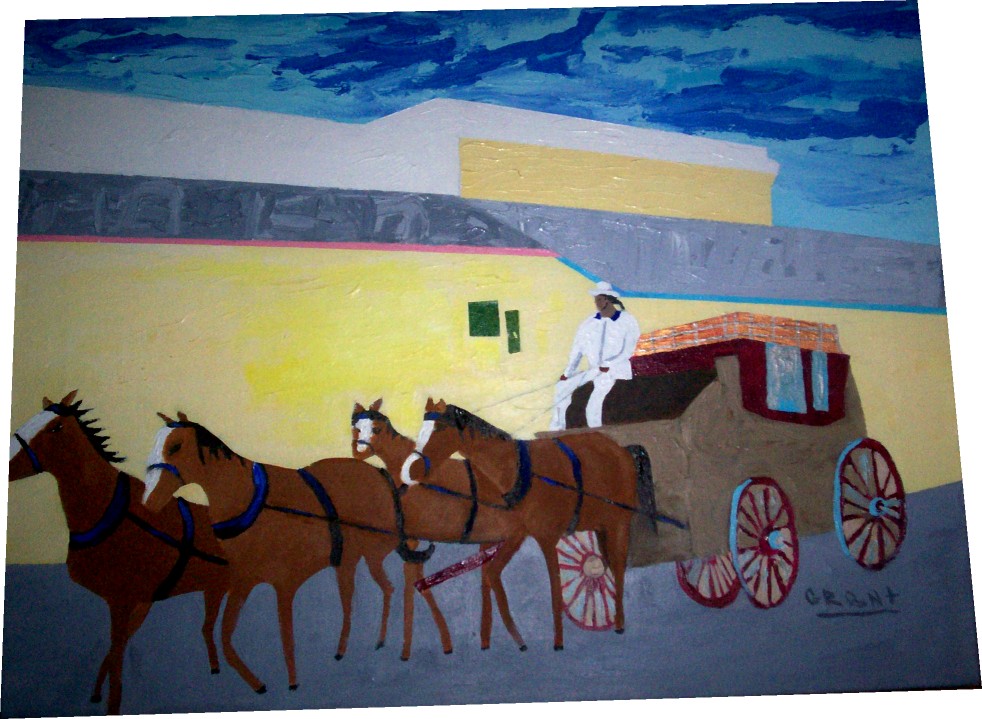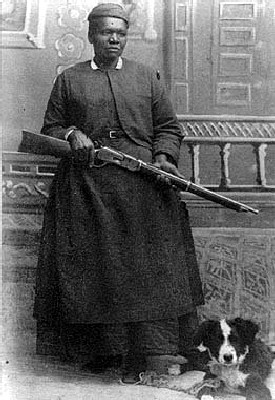
From the Washington Post article entitled, "In Denver, Black Cowboys Get Their Due," by Gary Lee, on June 24, 2007 -- One corner was devoted to "Stagecoach Mary," the burly former slave who became one of the best-known mail carriers in central Montana in the late 1800s. In another was a plaque about Nat Love, a famed 19th-century African American horse breaker, roper and ranch hand.
Never mind that these and most of the other folks featured at the Black American West Museum and Heritage Center lived well over a century ago. The museum, making skillful use of photographs, costumes and other displays, offers up their stories as if they were all still bellied up to the bar at the corner saloon.

And what stories! The saga of Mary Fields (a.k.a. Stagecoach Mary) -- a hard-drinking, pistol-packing woman born into slavery in 1832 and later the self-declared protector of nuns in a Cascade, Mont., convent and a stagecoach mail deliverer -- has all the rich texture of a great western novel. When her coach was overturned by a pack of wolves, she is said to have single-handedly pulled it into Cascade on her own.
Love's biography is equally enthralling. Also born a slave, Love was a cowhand in Dodge City, Kan., in the 1870s when he was teenager. From there, he became a champion roper and Colt .45 sharpshooter. In a contest in Deadwood, S.D., he was said to have shot from the hip, put 14 bullets in the bull's-eye of a target, and walked away with the $200 prize.
This lesser-known chapter of African American culture is on view in a quaint three-story Victorian building on a residential street near the downtown area of Colorado's capital. "Many African Americans played central roles in the early history of this part of the country," said Donald Larson, a museum board member. "We think the public deserves to know who they were and what they achieved."


And there are plenty of tales to tell. The early settlers of Colorado, Montana, Wyoming and the surrounding states included a sizable percentage of black fur trappers, soldiers, homesteaders, miners and other assorted types. A third of the cowboys in the early West were black, by the account of the museum's curators.
Besides the biographical sketches, the museum takes visitors through notable places and episodes in the black history of the West. A video tells the history of Dearfield, Colo., a town 75 miles north of Denver that was settled in the early 1900s as an all-black farm town. The town, whose population peaked at 700 in 1921, became prosperous. With the Depression, however, the farms went bust, and by the '40s it had become a ghost town. The museum has purchased several Dearfield lots and is seeking to help revive the town.

Most of the people and events highlighted in the exhibits date to the 18th, 19th or early 20th centuries. But a prominent room is devoted to Justina Ford, the first African American woman doctor in Colorado. The pediatrician and gynecologist lived and practiced in the house where the museum is located until her death at age 81 in 1952.
The museum is the handiwork of Paul Stewart, a retired Denver barber. After touring the United States collecting photos, books and memorabilia, he opened the museum in 1971. Since then, the collection has grown, and Stewart's brainchild has become a fixture on Denver's landscape of curious attractions.
But you'd be hard-pressed to find a more touching look at the Buffalo Soldiers, the military force deployed across the frontier states between the late 1860s and the early 1890s. The storied saga of the Ninth and 10th cavalries included service subduing Mexican revolutionaries and Native Americans. Poignant black-and-white photographs of the troops and memorabilia adorn one cove of the museum.

Living African American characters also occasionally appear at the museum. On the Saturday I visited, Maurice Wade, a local African American roper and rodeo rider, was on hand. He offered visitors a mini-lesson in cattle roping and bronco riding.
"I'm just trying to honor the path that the great black cowboys of the past have made for us," he said. [source: Washington Post, by Gary Lee]

No comments:
Post a Comment